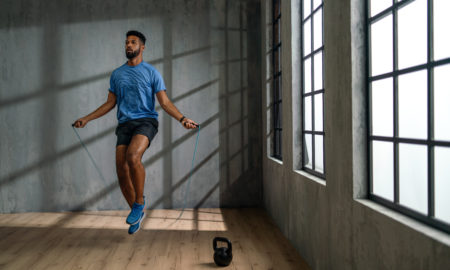Gym myths and weight-training injuries are a never-ending source of material for this column. For example, placement of the shoulder blades: What should you do with your shoulder blades during back training?
Years ago articles noted that trainees should attempt to spread their shoulder blades apart during pullups and pulldowns. Other articles countered that trainees should squeeze their shoulder blades together during the same exercises. I say, do neither.
The part of the brain that coordinates motion is the cerebellum. It can and should coordinate the sequential and concurrent firing of the muscles that make a movement happen. You can’t consciously do that better than the cerebellum can. When you start to interfere with the natural order of muscle firing to achieve a movement, you risk injury. That was apparent when I saw patients coming to my office for strains to muscles around the shoulder blades after such articles were published. The strained muscles were typically the rhomboids, the middle and lower trapezius muscles, the levator scapulae and the teres major.
There is much talk in gyms of trying to make muscles work a certain way—usually the way the trainer thinks the muscle should work. Those ideas often have no basis in scientific fact. An example of altering muscle-firing patterns occurred a few years ago.
One of the fastest players in the NHL was brought to me for recurring groin injuries. He had seen a therapist who claimed the player wasn’t using his glutes and his abs properly. This therapist advised the hockey player to start his skating stride by contracting his abs and pulling the hip through. First, I reminded the player that he was one of the fastest players in the NHL. His glutes and abs were firing just fine, or he wouldn’t be one of the fastest players.
Second, I told him that he couldn’t change the way his body recruits muscles to sprint that fast, and a therapist who’s not an elite sprint coach shouldn’t be changing his stride mechanics. The player said that the therapist had told him he wasn’t changing his stride mechanics. I responded that of course his mechanics were being changed. Can you imagine elite track sprint coach John Smith telling former 100-meter record holder Maurice Greene to start his stride by pulling with his abs first? Maurice would have slowed from 9.79 seconds to 10.5 seconds or worse.
You shouldn’t try to change how your body recruits and coordinates muscle action and movement. You have a wide variety of weight-training exercises and angles available that can cause different effects of muscle development, but you must still let your body synchronize the movement appropriately. You can perform bench presses and flyes flat or on a mild or steep incline or decline, or you can train your pecs with dips. You can train legs with back squats, front squats, hack squats, sissy squats, leg presses, prone leg curls, seated leg curls, stiff-legged deadlifts or Romanian deadlifts. The list goes on for shoulders, biceps, triceps, etc. Slight variations in exercise selection can make a difference in an elite amateur or professional bodybuilder, but the differences are often too subtle to notice in a beginner’s training program.
My point, again, is that you shouldn’t change how your body coordinates a movement. Just select a different movement and know your brain will coordinate it well. Be careful about listening to false authorities. In any arena there’s rarely a good outcome from following the advice of people who don’t know what they’re doing.
Editor’s note: Visit www.SoftTissueCenter.com for reprints of Horrigan’s past Sportsmedicine columns that have appeared in IRON MAN. You can order the books, Strength, Conditioning and Injury Prevention for Hockey by Joseph Horrigan, D.C., and E.J. “Doc” Kreis, D.A., and the 7-Minute Rotator Cuff Solution by Horrigan and Jerry Robinson from Home Gym Warehouse, (800) 447-0008, or at www.Home-Gym.com.




















You must be logged in to post a comment Login